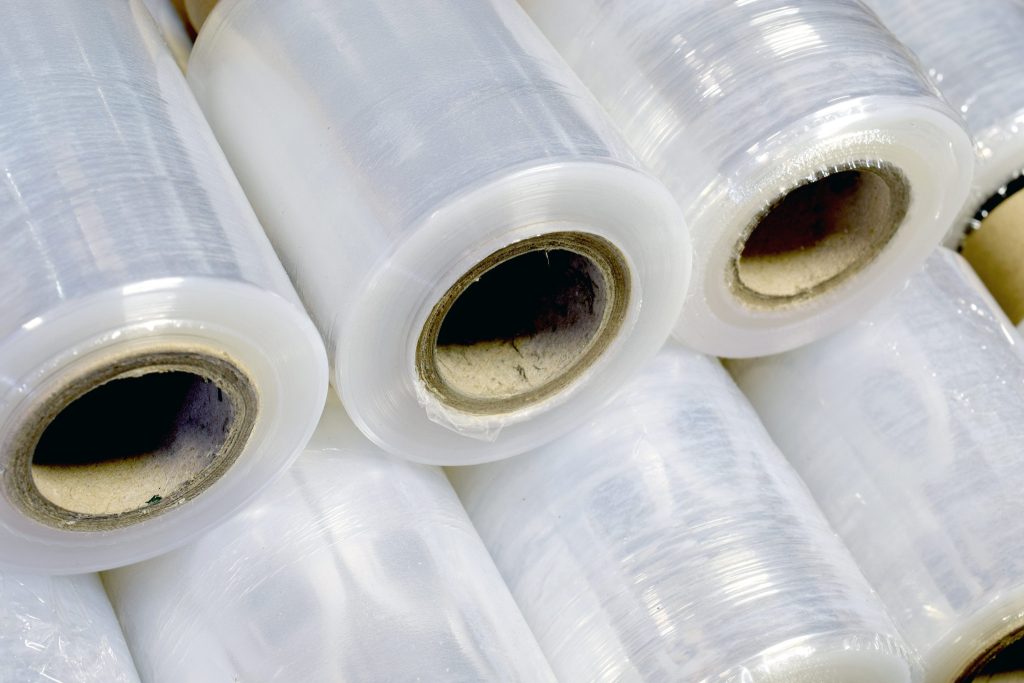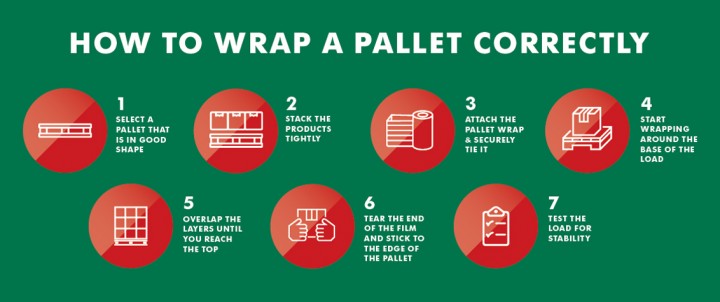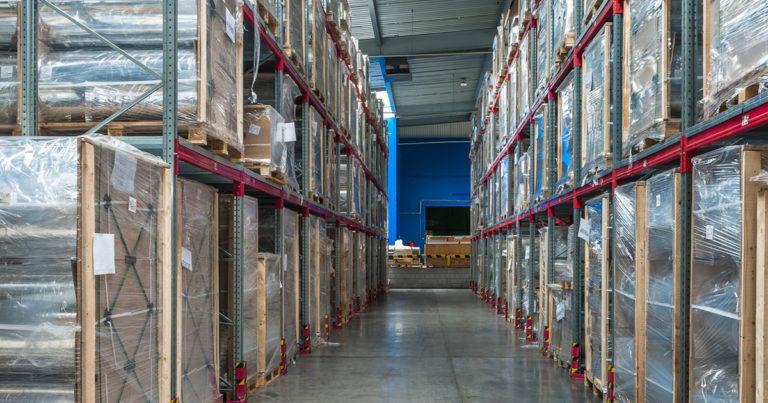Where to Buy and How to Use Pallet Wrap
Where to Buy and How to Use Pallet Wrap

Pallet wrap plays an important role in the packaging world. Wrapping pallets is a cost-effective and fast way to protect your goods through transit. In this guide, we’ll take you through exactly what pallet wrap is and how to wrap a pallet correctly.
What is Pallet Wrap?
Pallet wrap is a highly stretchable film, which is also often referred to as ‘stretch film’ or ‘stretch wrap’. It is most commonly used for wrapping around items on a pallet. The elastic recovery ensures the items are tightly bound and fully secured for transit.
By securing the load, product loss and tampering are reduced. Goods can also be protected against certain weather conditions, dust and light debris. Black or tinted stretch films are ideal for transporting goods that cannot be exposed to an excessive amount of sunlight, such as electronic items.
Versatile and highly durable, pallet wrap is primarily used in factories, manufacturing and storage. It can also be used for many everyday items such as furniture, windows and food packaging.
What is Pallet Wrap Made From?
Pallet wrap is a plastic film most commonly made from linear low-density polyethylene (LLDPE). The manufacturing process involves heating and compressing resin (the small pellets of plastic material) at the specific temperature according to the viscosity required. It is then pushed through an annular die to create a continuous layer of plastic. Other resins and additives can be included such as pigment, tackifier and UV resistance.
How to wrap a pallet correctly
Knowing how to wrap a pallet properly will greatly reduce the risk of damage during transit or in storage. To ensure your pallet is wrapped correctly, simply follow our tips:
To wrap a pallet correctly, you can either use a pallet wrapping machine or do it by hand. A pallet wrapping machine will automate the process, resulting in a perfectly wrapped pallet in just a matter of moments. Doing it by hand is a very manual process more suited to smaller operations.
Robopac provide leading pallet wrapping machines and you can see how to use one of their machines in the video below:
For more Robopac videos, take a look at our playlist on Youtube.
Instructions for Wrapping a Pallet
Wrapping a pallet by hand follows a very similar process but is a very manual process. Whether you’re wrapping pallets using a machine or by hand, you can follow the simple steps below as a guide to wrapping pallets:
- First, select a pallet that doesn’t have any broken boards, and is a similar size to the load you want to wrap.
- Stack the products as closely as possible. Also, ensure the weight distribution is evenly spread, with heavier items at the bottom, and lighter items towards the top.
- Attach the wrap by threading it through a corner of the pallet, and tying it until it’s fully secure.
- Start wrapping around the base of the load. Then wrap your way around at least 3 or 4 times, ensuring the corners are tightly wrapped.
- Work your way up with the layers overlapping. Once you’ve reached the top, start wrapping back down so the load is stable.
- When the entire load is safely wrapped, tear the end off and either stick it, or tuck it under, the edge of the pallet.
- Upon completion, test the load for stability by lightly pushing the top items. If none of the items are loose or move, then you can be sure the load is sturdy and won’t shift during transport.

Take a look at this video which shows how to wrap a pallet correctly:
Types of Pallet Wrap
There are three main types of pallet wrap to look out for:
Pre-stretch film – the film is stretched during its manufacture, which can increase its overall strength. This improves the stability of your pallet as
Cast Stretch film – a very versatile type of pallet wrap which provides excellent strength.
Blown Stretch film – incredibly strong pallet wrap with high puncture and tear resistance. Typically used for irregular loads to ensure your pallet remains stable.
Do You Need Light-Duty, Medium-Duty or Heavy Duty Pallet Wrap?
Light Duty – general purpose pallet wrap with a low thickness level. Ideal for well stacked pallet loads made up entirely of similarly shaped boxes.
Medium Duty – more robust than light duty and should be used when your pallet is made up of some additional irregular shaped boxes, such as poster boxes.
Heavy Duty – a very robost pallet wrap film with high levels of tear and puncture resistance. Use this type of pallet wrap when you have lots of irregular shaped boxes and sharp edges.
Note: for extra protection from sharp edges, you can use edge guards and corner protectors.
Where to Buy Pallet Wrap?
You can buy pallet wrap online from packaging specialists such as ourselves. At Springpack, we sell an extensive range of pallet wrap, from heavy duty and pre-stretched pallet wrap, to tinted wrap.
By choosing the right gauge of film, you can securely wrap almost any weight, shape, or size of a pallet. All of our pallet wrap is sold in boxes of six, and next working day delivery is also available.
Can Pallet Wrap be Recycled?
Because pallet wrap is made from LLDPE, it can be recycled. This is classed as category four in recycling programmes, meaning you can reduce your business’ packaging wastage. However, it can’t currently by collected and recycled with hard plastics. This is because the pallet wrap could get stuck in the equipment. Instead, pallet wrap is accepted at collection points located in most major supermarkets if you are unable to re-use it.
To successfully recycle pallet wrap you must ensure it is clean, with no sticky labels present. You can find your closest recycling facility by entering your postcode in the Recycle Now website.
By choosing the right gauge of film, you can securely wrap almost any weight, shape, or size of a pallet. All of our pallet wrap is sold in boxes of six, and next working day delivery is also available.
Can You Buy Eco-Friendly Pallet Wrap?
Yes, Simply Eco pallet wrap is made up of 30% recycled materials, making it one of the most eco-friendly pallet wraps available.
As well as choosing an eco-friendly pallet wrap, you can also reduce your usage of plastic by wrapping your pallets as efficiently as possible.
What is the difference between Pallet Stretch Wrap and Pallet Shrink Wrap?
When it comes to finding the right solution to protect products while in transit, stretch and shrink wraps are the most popular choices. Despite these types of wrapping having many differences, they are regularly confused.
Pallet stretch wrap has a strong elastic property and a two-sided cling so it can easily stick to itself. This type of wrap is ideal for holding large loads together on a pallet. It offers protection from dust, moisture and UV. It is also a very adaptable, with a variety of films available for different applications and surfaces. Stretch is the more cost-effective choice too.
Pallet shrink wrap is commonly made from polyolefin, and is covered loosely around a single product or small loads. It then shrinks tightly when heat is applied. This type of wrap is primarily used for covering food and protecting products from all types of weather and moisture as it sucks out the air. Shrink wrapping also has the capability to be ventilated if needed, making it more breathable. This further reduces the risk of damage caused by moisture.
If you’re unsure on which type of product is right for you, our helpful team will be able to advise you on the best solutions. Simply give us a call on 01905 457 000 or send an e-mail to [email protected].

How many pallets will a roll of shrink wrap cover?
We get asked this a lot. And it all depends on what you are wrapping – the size of the pallet, and the goods being wrapped. If the pallet height is short, you will use less wrap. If you happen to be wrapping a pallet that is already incredibly sturdy, again, you will use less wrap. We generally recommend conducting a free Packaging Audit, so we offer some hints and tips on reducing the amount of wrap you are using.
If you have any questions or need more information about any of our products, give our friendly and knowledgeable team by
Were Here to Help Guide Inform




